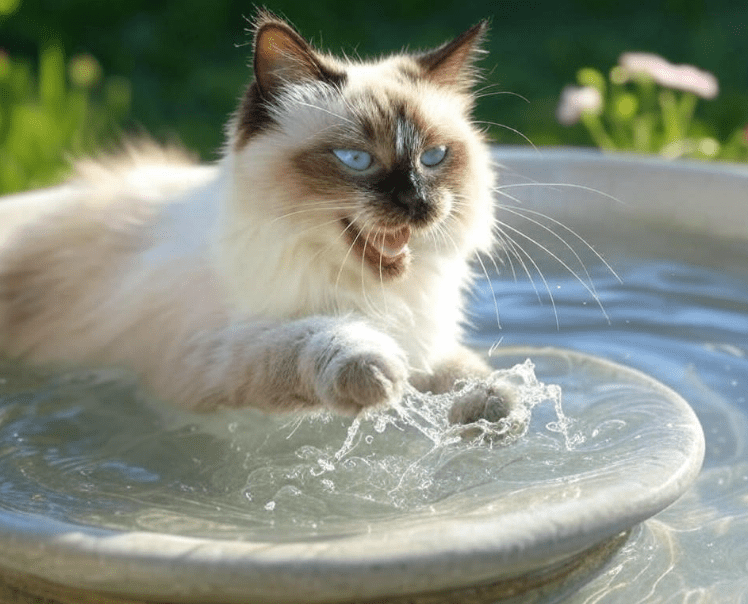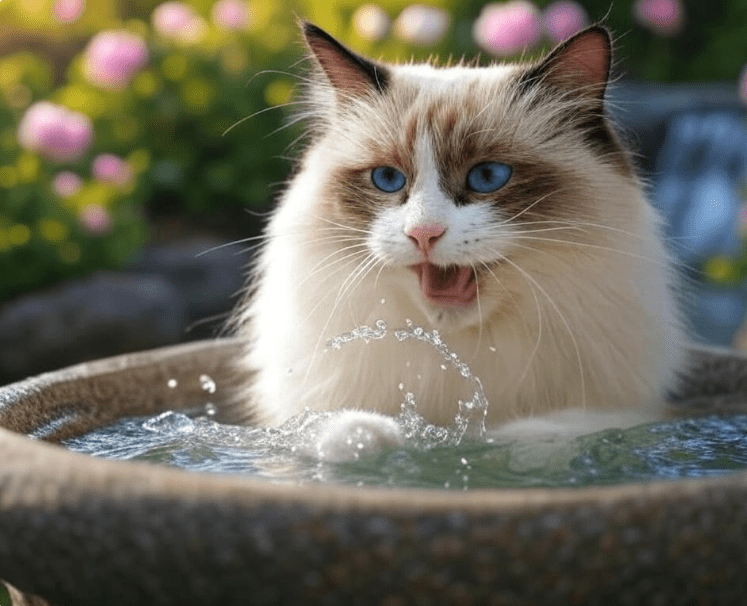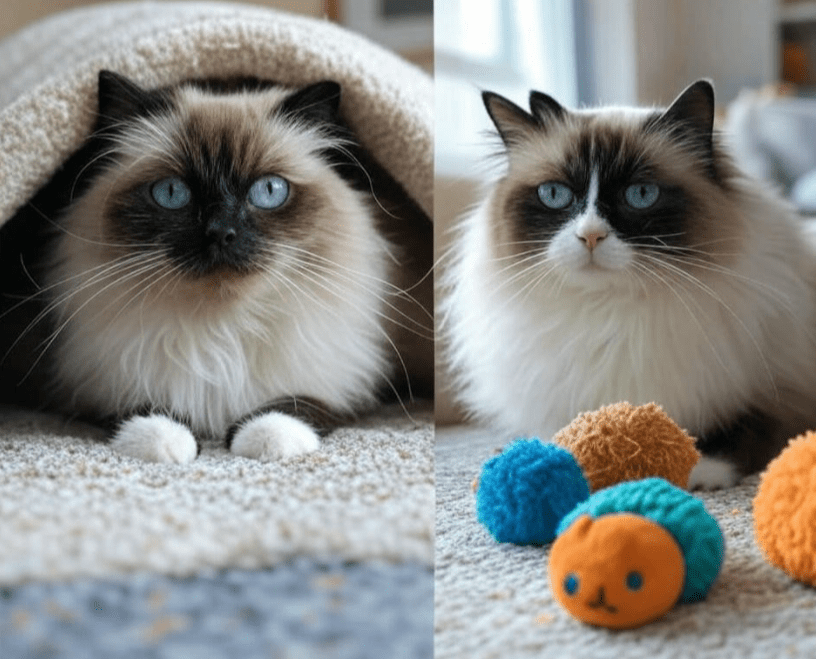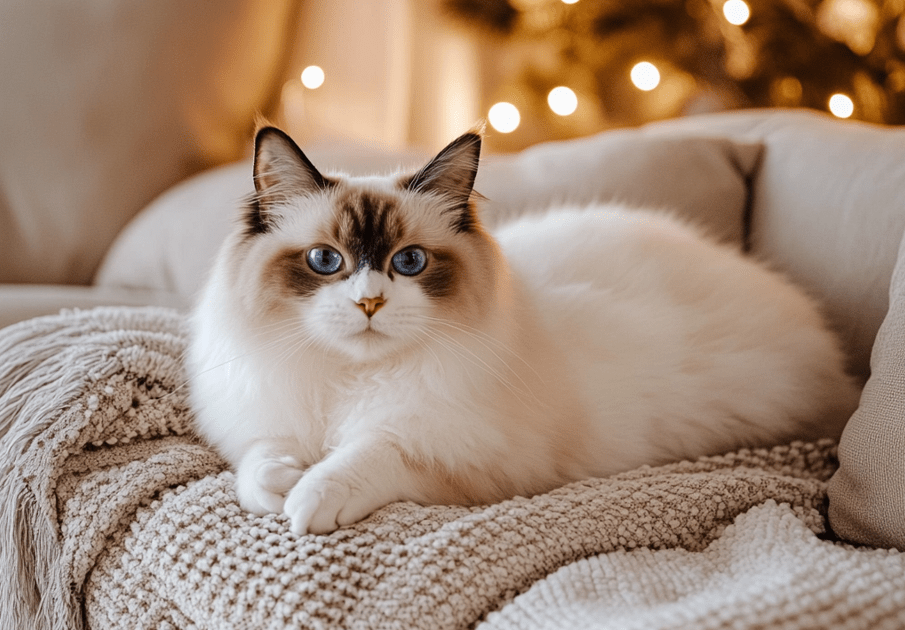
Unlike most cats, Ragdoll cats often display a surprising affinity for water, making bath time a unique experience for their owners. The Ragdoll cat’s love for water sets them apart from other breeds, turning what could be a stressful chore into an opportunity for bonding and fun. But why do these fluffy felines enjoy splashing around, and how can you ensure bath time is safe and enjoyable? This comprehensive guide explores the reasons behind their water-loving nature, offers practical tips for safe bathing, and provides insights into making the experience stress-free for both you and your Ragdoll.
From understanding their unique personality to creating a bath-time routine, this article is your go-to resource for everything you need to know about why Ragdoll cats love water and how to make the most of it.
Understanding the Ragdoll Cat’s Personality
Ragdolls are renowned for their gentle, affectionate, and docile nature, often described as “puppy-like” due to their love for human companionship. These traits play a significant role in their unusual comfort with water compared to other cat breeds. To understand why Ragdolls are drawn to water, let’s first look at their personality and physical characteristics.
Key Traits of Ragdolls
Curious and Playful: Ragdolls are naturally curious, and water—whether it’s a dripping faucet or a shallow tub—can spark their interest as a playful element.
Relaxed Demeanor: Their calm temperament means they’re less likely to panic during bath time, especially if introduced to water early.
Social Bonding: Ragdolls thrive on interaction with their owners, and bath time can become a positive, shared activity.
Soft, Water-Repellent Coat: Their semi-long, plush fur is less prone to matting when wet, making water exposure more comfortable than for breeds with denser coats.
These traits combine to make Ragdolls more open to water-related activities, but their love for water isn’t universal. Factors like early exposure, individual temperament, and environment also influence their behavior.
Why Do Ragdoll Cats Love Water?
While not every Ragdoll will jump into a bathtub, many show an unusual fascination with water. Here are the key reasons behind this behavior:

1. Instinctive Curiosity
Ragdolls have a strong sense of curiosity, often investigating anything that moves or sparkles. Running water, whether from a faucet or a pet fountain, mimics the movement of prey, triggering their playful instincts. This curiosity can extend to bathtubs, sinks, or even puddles, where they may paw at or watch the water intently.
2. Positive Early Experiences
Ragdolls exposed to water during kittenhood are more likely to develop a positive association with it. Breeders or owners who introduce gentle baths or water play early on can shape a Ragdoll’s comfort with water, making bath time a familiar and enjoyable routine.
3. Attraction to Sensory Stimulation
Water provides a multi-sensory experience—visual (ripples and splashes), auditory (dripping or flowing sounds), and tactile (wet sensations). For a Ragdoll, these stimuli can be engaging and fun, especially if they associate water with playtime or attention from their owner.
4. Comfort with Human Interaction
Ragdolls are highly social and often enjoy activities involving their owners. Bath time, when approached with care, can become a bonding experience, as the cat associates the warm water and gentle touch with affection and trust.
5. Unique Coat Structure
The Ragdoll’s coat is less prone to waterlogging compared to other long-haired breeds. Their fur repels water to some extent, drying relatively quickly and reducing discomfort. This physical trait makes water exposure less stressful, encouraging their water-loving tendencies.
6. Environmental Influences
Ragdolls living in homes with accessible water sources—like pet fountains, leaky faucets, or open bathtubs—may develop a fascination with water simply because it’s part of their environment. Owners who encourage playful interactions with water (e.g., letting them bat at a stream from a faucet) reinforce this behavior.
Preparing for a Safe Bath Time
To make bath time a positive experience for your Ragdoll, preparation is key. Proper setup and a calm approach ensure safety and comfort for both you and your cat. Here’s how to get started:

1. Gather Supplies
Before bathing your Ragdoll, have these items ready:
Cat-Safe Shampoo: Use a gentle, veterinarian-approved shampoo designed for cats. Avoid human shampoos, which can irritate their skin.
Non-Slip Mat: Place a rubber mat or towel in the tub or sink to prevent slipping.
Warm Water: Fill the tub or sink with 2–4 inches of lukewarm water (around 100°F/38°C) to keep your cat comfortable.
Towels: Have several soft, absorbent towels for drying.
Brush: Groom your Ragdoll before the bath to remove loose fur and prevent matting.
Treats and Toys: Use these to reward calm behavior and create positive associations.
Pitcher or Handheld Sprayer: These allow controlled water application, avoiding the face.
2. Create a Calm Environment
Choose a Quiet Time: Bathe your Ragdoll when the house is calm to minimize stress.
Close Doors: Prevent escapes and reduce distractions by keeping the bathroom door closed.
Use Pheromone Products: A Feliway diffuser or spray can help soothe your cat.
3. Acclimate Your Ragdoll to Water
If your Ragdoll is new to baths, introduce water gradually:
Start with Play: Let them explore a dry tub or play with a dripping faucet to build familiarity.
Use a Damp Cloth: Wipe their fur with a warm, damp cloth to mimic the bath experience.
Short Practice Sessions: Place them in a tub with a small amount of water for a few seconds, rewarding them with treats.
4. Health and Safety Checks
Vet Approval: Ensure your Ragdoll is healthy before bathing, as skin conditions or ear infections can worsen with water exposure.
Ear Protection: Place cotton balls gently in their ears to prevent water entry, but remove them immediately after the bath.
Nail Trimming: Trim their nails a day before to reduce the risk of scratches.
Step-by-Step Guide to Bathing a Ragdoll Cat
Follow these steps to make bath time safe, effective, and enjoyable for your water-loving Ragdoll:
Step 1: Pre-Bath Grooming
Brush your Ragdoll thoroughly to remove loose fur and tangles. This reduces matting and makes the bath more comfortable. Pay special attention to their undercoat, as Ragdolls have dense fur that can trap debris.
Step 2: Set Up the Bath Area
Fill the tub or sink with lukewarm water (2–4 inches deep). Place a non-slip mat at the bottom and keep all supplies within reach. Test the water temperature with your wrist to ensure it’s not too hot or cold.
Step 3: Introduce Your Ragdoll to the Water
Gently place your Ragdoll in the tub, supporting their body to keep them secure. Speak in a calm, reassuring tone and avoid sudden movements. If they seem nervous, pause and offer a treat or toy.
Step 4: Wet Their Fur
Using a pitcher or handheld sprayer, wet your Ragdoll’s body, starting from the neck and working toward the tail. Avoid the face and ears to prevent discomfort. Use slow, gentle motions to keep them calm.
Step 5: Apply Shampoo
Apply a small amount of cat-safe shampoo, lathering it into their fur with gentle massages. Focus on areas prone to dirt, like the legs and belly, but be careful around the eyes and mouth. Ragdolls often enjoy this part, as it mimics petting.
Step 6: Rinse Thoroughly
Rinse all shampoo from their fur using lukewarm water. Ensure no residue remains, as it can irritate their skin. Double-check under the legs and belly, where soap can hide.
Step 7: Dry Your Ragdoll
Wrap your Ragdoll in a soft towel and gently pat them dry. If they tolerate it, use a low-heat, pet-safe blow dryer on the lowest setting, keeping it at least 12 inches away. Brush their fur during drying to prevent matting.
Step 8: Post-Bath Rewards
Offer treats, praise, or playtime to reinforce the positive experience. Check their ears for moisture and clean them gently with a vet-approved solution if needed.
Tips for Making Bath Time Fun for Ragdolls
To enhance your Ragdoll’s love for water and make bath time a highlight, try these strategies:
Incorporate Play: Float a ping-pong ball or rubber toy in the bath to engage their playful side.
Use a Pet Fountain: Encourage their water fascination with a cat-safe drinking fountain, which can make water a familiar, fun element.
Keep It Short: Limit baths to 10–15 minutes to avoid overstimulation, especially for first-timers.
Create a Routine: Bathe your Ragdoll every 4–6 weeks (or as needed) to maintain their coat and reinforce familiarity.
Involve Treats: Place a treat near the tub or reward them during the bath for calm behavior.
Try a Showerhead: Some Ragdolls enjoy the gentle spray of a handheld showerhead, which mimics a dripping faucet.
Common Challenges and Solutions
Even water-loving Ragdolls may face bath-time challenges. Here’s how to address them:
1. Initial Nervousness
Solution: Slow the process by introducing water in small steps. Use a calm voice and reward calm behavior with treats.

Pro Tip: Start with just their paws in water and gradually increase exposure.
2. Dislike of Water on Face
Solution: Use a damp washcloth to clean their face instead of pouring water. Avoid spraying or splashing near their eyes.
Example: Gently wipe their face after the bath to keep it shampoo-free.
3. Matting Fur Post-Bath
Solution: Brush thoroughly before and after the bath. Use a detangling spray if needed, and dry their fur completely to prevent tangles.
Expert Tip: Focus on the underbelly and tail, where matting is common.
4. Stress or Resistance
Signs: Hissing, hiding, or trying to escape.
Solution: Pause the bath and give your Ragdoll a break. Use pheromone products and try again later with a slower approach.
How Often Should You Bathe a Ragdoll?
Ragdolls don’t require frequent baths due to their self-grooming habits and low-maintenance coats. However, occasional baths can keep their fur clean and healthy. Here’s a guide:
General Rule: Bathe every 4–6 weeks, or as needed (e.g., if they get dirty or have skin issues).
Show Cats: Ragdolls in cat shows may need weekly baths to maintain a pristine coat.
Skin Conditions: Consult your vet for bathing frequency if your Ragdoll has allergies or dermatitis.
Avoid Over-Bathing: Excessive bathing can strip natural oils, leading to dry skin or irritation.
Always monitor your Ragdoll’s skin and coat after baths. If you notice dryness, redness, or excessive scratching, reduce bathing frequency and consult a veterinarian.
Safety Precautions for Bathing Ragdoll Cats
To ensure bath time is safe, follow these precautions:
Never Leave Unattended: Always stay with your Ragdoll during the bath to prevent slips or drowning.
Check Water Temperature: Lukewarm water (100°F/38°C) is ideal. Too hot or cold can cause stress or injury.
Avoid Submerging: Keep water levels low (2–4 inches) and never submerge their head.
Use Cat-Specific Products: Human shampoos or soaps can harm their skin and coat.
Monitor Post-Bath Behavior: Watch for signs of stress, ear infections, or skin issues after bathing.
Encouraging Your Ragdoll’s Love for Water Beyond Bath Time
To nurture their water-loving nature, incorporate water-based activities into their routine:
Pet Fountains: Provide a cat-safe water fountain to encourage drinking and play.
Dripping Faucets: Let them explore a slow-dripping faucet under supervision.
Shallow Water Play: Fill a shallow basin with water and floating toys for interactive fun.
Supervised Outdoor Water: If safe, let your Ragdoll explore a small kiddie pool or sprinkler in a secure outdoor area.
Always supervise water play to ensure safety, and avoid forcing your Ragdoll into water-based activities if they seem uninterested.
Expert Insights on Ragdolls and Water
Veterinarians and feline behaviorists offer these insights to enhance your Ragdoll’s water experience:
Start Early: Kittens are more adaptable, so introduce water play or baths during their first year for lasting comfort.
Observe Individual Preferences: Not all Ragdolls love water equally. Respect your cat’s boundaries and tailor activities to their comfort level.
Consult a Vet: If your Ragdoll shows excessive water fascination (e.g., obsessively drinking or playing), rule out medical issues like diabetes or kidney problems.
Use Positive Reinforcement: Consistent rewards during water exposure build trust and enthusiasm.
Conclusion

The Ragdoll cat’s love for water is a delightful quirk that sets them apart from other breeds. By understanding the reasons behind their affinity—curiosity, early experiences, and a water-friendly coat—you can create a bath-time routine that’s safe, fun, and stress-free. With the right preparation, tools, and techniques, bath time can become a bonding experience that strengthens your connection with your Ragdoll. Whether they’re splashing in a tub or chasing a dripping faucet, this guide equips you with everything you need to nurture their water-loving nature while keeping them healthy and happy.




